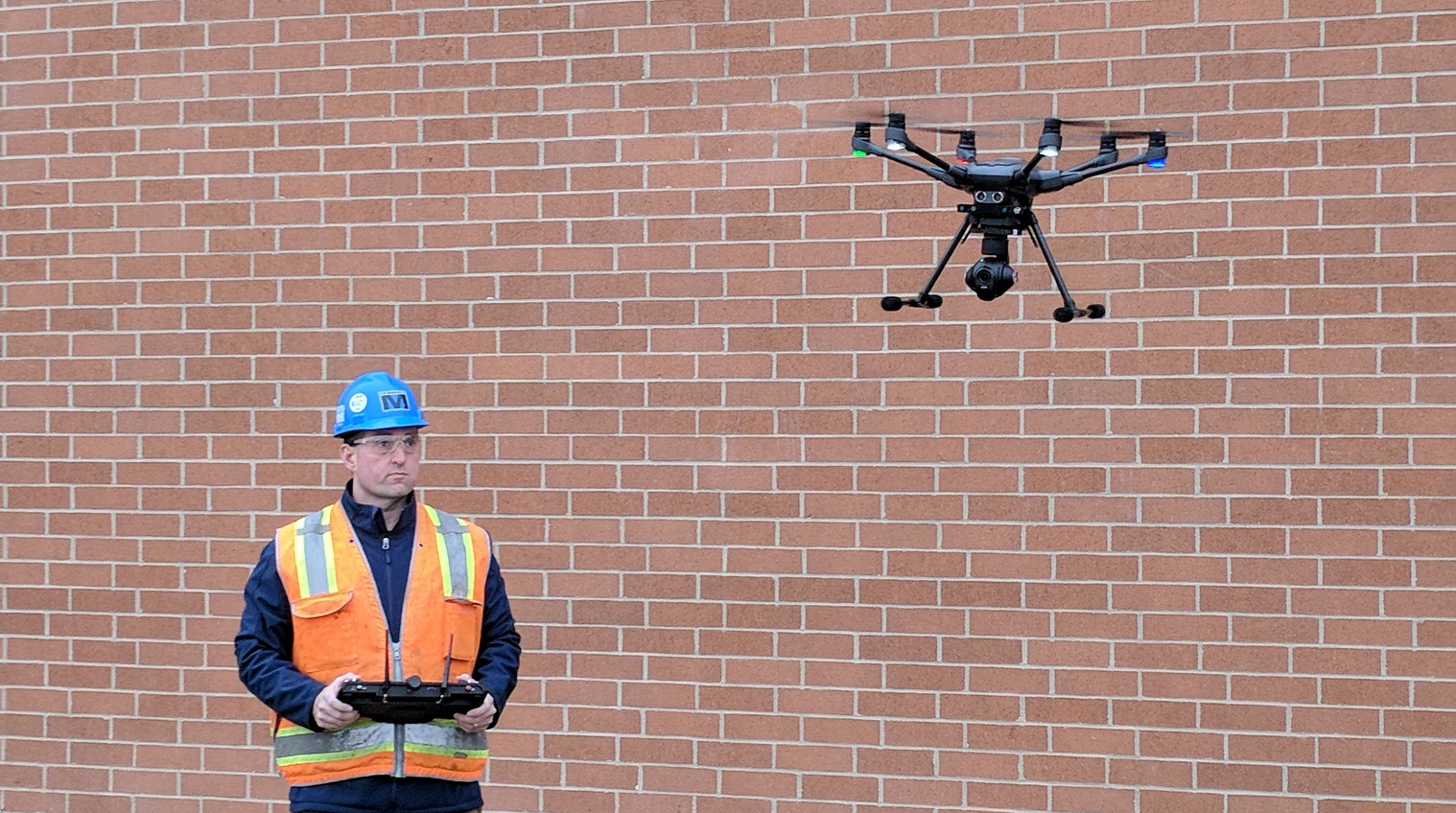Jason Galoozis, Safety Director of FE Moran, flying a drone
Sarah Noel Block is the Director of Marketing & Education for The Moran Group. The Moran Group, based in Northbrook, IL, provides HVAC, plumbing, and fire protection design/build and inspection/testing/maintenance services for commercial, residential, industrial, and government properties.
The “fatal four” are falls, electrocutions, struck by an object, and caught in/between. Falls alone cause over half of the deaths in construction. With today’s technology, the fatal four could be a thing of the past.
Hard hats, safety glasses, and harnesses are all well and good, but with the latest technology, construction workers can be more like Iron Man in the field.
1) Exoskeletons
Construction workers are in situations that add stress to the body. The Center for Disease Control and Prevention (CDC) says that construction workers are 16% more likely – than all industries combined – to have a work-related musculoskeletal disorder. Those days can be over with exoskeletons. Exoskeletons started in the medical industry to help train people to walk again. Like many of the technologies in this post, the inventors saw a need for them in the construction industry. Exoskeletons come in two forms: power assist and unpowered. Unpowered improves posture and takes strain off the body with counterweights. Power assist exoskeletons use sensors and motors. These help construction workers lift heavy objects and work longer without fatigue. Currently in the works, Ekso Bionics is buildings exo-arms that have tool attachments.
2) Wearables:
Over the past week, I have been wearing a watch that tracks my location and vitals. Why? I am helping to test the technology for a job that F.E. Moran Special Hazard Systems is starting. Wearables don’t just track location. They eliminate the “Fatal Four.” Human Condition, used by Bechtel, Turner, and Clark, have created smart safety vests and hard hats. The equipment has sensors, GPS, real time locating, and vital tracking. Solar and kinetic energy charges the wearables. By moving outside, in the sun, construction workers keep the equipment charged. The CEO of Human Condition said, “We built Human Condition Safety to really help the serious issue of construction workers being injured and killed on job sites. It just feels like such an old problem that needs to be addressed, and we’re aiming by 2025 to eliminate deaths on job sites globally.”
3) Site Sensors:
It is estimated that 1.3 million construction workers are exposed to asbestos each year on the job. Asbestos causes mesothelioma, a tumor that affects the tissue of the lungs, stomach, heart, and other organs. It affects about 20,000 people per year with no cure. Asbestos can be found in floor tile, roofing, shingles, siding, plasters, fire proofing and other construction materials made through the early 80s. Many mesothelioma victims are construction workers, but that can be a thing of the past with site sensors. The sensors will be able to read toxins in the air, including asbestos, so proper precautions can be made. Site sensors can also read the temperature and moisture levels in the air, sending the data to superintendents and foreman. This gives on-site personnel enough data to know if a fire ignited in an unmanned room or the plumbing sprung a leak. Imagine how much money could be saved if these incidents are caught on the onset of the problem.
4) Drones:
Drones are becoming widely adapted by construction companies to monitor job sites. Drone usage allows construction companies to inspect, scan for hazards, and monitor jobs from an aerial view. The Moran Group recently started using drones for safety purposes. Jason Galoozis, Safety Director, said, “Drones will play a critical part in future safety inspections at F.E. Moran. Drones can eliminate the need for company employees or the safety team to conduct high risk pre-project start inspections on elevated surfaces. These elevated surfaces could be older or abandoned structures which could pose serious hazards to our employees.”
5) Virtual Reality:
Virtual reality for construction training is changing the industry for the better. Bechtel Construction recently launched a virtual reality training program. The virtual reality program replicates a construction site. Workers are able to interact with the environment and simulate the job without the cost of actually needing to bring the men to a site. Virtual reality isn’t used only in safety training. BIM360 allows designers to walk through their design using a DAQRI Smart Helmet . With this platform, they can see potential problems in the design and fix it before construction even begins. While virtual reality is expensive to implement, it reduces the cost of training long-term. During the lifetime of the system, construction companies will see a reduced cost in training.
What if the fatal four could be eliminated? The hundreds of construction workers that die each year would still be alive. With the use of exoskeletons, wearables, site sensors, drones, and virtual reality it’s a very real possibility that construction sites can get to a 0-incident rate.











Last summer, Hilti announced that they had developed their first exoskeleton designed for construction tradespeople in a partnership with Ottobuck, a prosthetics, orthotics, and exoskeleton provider. Earlier this month, Hilti officially released the exoskeleton, announced more details, and published its retail price on their website.